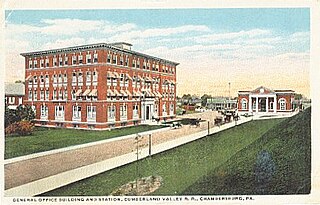
The Western Maryland Railway was an American Class I railroad (1852–1983) that operated in Maryland, West Virginia, and Pennsylvania. It was primarily a coal hauling and freight railroad, with a small passenger train operation.

The Capital Subdivision is a railroad line owned and operated by CSX Transportation in the U.S. state of Maryland and the District of Columbia. The line runs from near Baltimore, Maryland, southwest to Washington, D.C., along the former Baltimore and Ohio Rail Road (B&O) Washington Branch. The subdivision's Alexandria Extension provides a connection to Virginia and points south.
The Alphabet Route was a coalition of railroads connecting the Midwest United States with the Northeast, as a freight alternate to the four major systems: the Pennsylvania Railroad, New York Central Railroad, Erie Railroad and Baltimore and Ohio Railroad.

The Philadelphia & Reading Railroad Bridge carries Norfolk Southern rail lines across the Susquehanna River between Lemoyne, Pennsylvania and Harrisburg, Pennsylvania. Some of its concrete piers encase stone masonry piers from an earlier truss bridge on this site, completed in 1891 by the Philadelphia, Harrisburg and Pittsburgh Railroad, which was then acquired by the Philadelphia and Reading Railroad to connect its Harrisburg and Lurgan lines. The current structure was constructed from 1920 to 1924 by replacing the trusses with concrete arches one track at a time. The bridge has fifty-one concrete arches, three more than the nearby Rockville Bridge.

The Frederick Branch is a railroad line in Frederick County, Maryland. It was built by the Baltimore and Ohio Railroad (B&O) in 1831, and is now owned by the Maryland Department of Transportation (MDOT). The 3.4 mi (5.5 km) branch extends between Frederick Junction – a wye with the Old Main Line Subdivision of CSX Transportation on the west side of the Monocacy River – and its terminus at East Street in downtown Frederick, Maryland. The wye at Frederick Junction was the first example of its kind in the United States and is still in use today.

The Mountain Subdivision is a railroad line owned and operated by CSX Transportation in the U.S. states of Maryland and West Virginia. The line runs from Cumberland, Maryland, west to Grafton, West Virginia, along the original Baltimore and Ohio Railroad (B&O) main line. It was known as the West End Subdivision until the B&O's absorption into the Chessie System, and included the B&O's original crossing of the Allegheny Mountains. Through CSX traffic to the west from Cumberland now uses the Keystone Subdivision over Sand Patch Grade.

The Hanover Subdivision is a railroad line owned and operated by CSX Transportation in the U.S. states of Maryland and Pennsylvania. The line runs from Baltimore, Maryland, west to Hagerstown, Maryland, along several former Western Maryland Railway (WM) lines. It meets the Baltimore Terminal Subdivision at its east end, and the Lurgan Subdivision heads both north and west from its west end.

The Trenton Subdivision is a railroad line owned by CSX Transportation in the U.S. states of Pennsylvania and New Jersey. The line runs from CP NICE in Philadelphia, Pennsylvania, northeast to Port Reading Junction in Manville, New Jersey. The line was formerly part of the Reading Company system.

The Philadelphia Subdivision is a railroad line owned and operated by CSX Transportation in the U.S. states of Pennsylvania, Delaware, and Maryland. The line runs from Philadelphia, Pennsylvania, southwest to Baltimore, Maryland, along a former Baltimore and Ohio Railroad (B&O) line.

The Metropolitan Subdivision is a railroad line owned and operated by CSX Transportation in Washington, D.C. and Maryland.The 53-mile line runs from Washington, D.C., northwest to Weverton, Maryland, along the former Metropolitan Branch of the Baltimore and Ohio Railroad.

The CSX Cumberland Subdivision is a railroad line owned and operated by CSX Transportation in the U.S. states of Maryland and West Virginia. The line runs from Brunswick, Maryland, west to Cumberland, Maryland, along the old Baltimore and Ohio Rail Road (B&O) main line. At its east end, the Cumberland Subdivision becomes the Metropolitan Subdivision; at its west end at Cumberland, Maryland it becomes the Cumberland Terminal Subdivision. It meets the Shenandoah Subdivision at Harpers Ferry, West Virginia, and the Lurgan Subdivision in Cherry Run, West Virginia.

The Lurgan Branch is a railroad line owned and operated by the Norfolk Southern Railway in the U.S. states of Pennsylvania and Maryland. The line is part of the NS Harrisburg Division and runs from Harrisburg, Pennsylvania southwest to Hagerstown, Maryland along former Reading Company and Pennsylvania Railroad lines. Its northeast end is at a junction with the Harrisburg Line, Pittsburgh Line, Royalton Branch, and Amtrak's Keystone Corridor ; its southwest end is at the beginning of the Hagerstown District. At Lemoyne it intersects the Enola Branch.

U.S. Route 11 (US 11) is a part of the United States Numbered Highway System that runs from New Orleans, Louisiana, to Rouses Point, New York. In Maryland, the federal highway runs 12.83 miles (20.65 km) from the West Virginia state line at the Potomac River in Williamsport north to the Pennsylvania state line near Maugansville. US 11 is the primary north–south surface highway in central Washington County, connecting Hagerstown with Williamsport to the south and Hagerstown Regional Airport to the north. The federal highway was once a major long-distance highway, but that role has been assumed by Interstate 81 (I-81), which parallels US 11 not only in Maryland but for most of its course from Tennessee to Upstate New York. US 11 is maintained by the Maryland State Highway Administration except for the municipally-maintained portions within the corporate limits of Williamsport and Hagerstown.
The Hagerstown and Frederick Railway, now defunct, was an American railroad of central Maryland built in the 19th and 20th centuries.

The Cumberland Valley Railroad was an early railroad in Pennsylvania, United States, originally chartered in 1831 to connect with Pennsylvania's Main Line of Public Works. Freight and passenger service in the Cumberland Valley in south central Pennsylvania from near Harrisburg to Chambersburg began in 1837, with service later extended to Hagerstown, Maryland, and then extending into the Shenandoah Valley to Winchester, Virginia. It employed up to 1,800 workers.
The Patterson Creek Cutoff is an abandoned railroad line built by the Baltimore and Ohio Railroad (B&O) in northern West Virginia and Western Maryland, that served trains running on the B&O "West End" line in the Cumberland, Maryland area. The cutoff route ran from McKenzie, Maryland to Patterson Creek, West Virginia, providing a bypass of the B&O rail yard in Cumberland for coal trains moving between Keyser, West Virginia and Brunswick, Maryland.

Pennsylvania Route 997 is a 49.0-mile (78.9 km) route that is located in Franklin and Cumberland counties in central Pennsylvania in the United States. This route runs from the Maryland state line south of Waynesboro, where the road continues into that state as Maryland Route 64, north to PA 233 in the Upper Mifflin Township community of McCrea.

The Cumberland Terminal Subdivision is a railroad line owned and operated by CSX Transportation in the Cumberland, Maryland area. The line centers on the Cumberland rail yard and is a junction with three other subdivisions.
The Georges Creek Subdivision is a railroad line with portions owned and operated by either CSX Transportation or the Georges Creek Railway in the U.S. state of Maryland. The line runs from Westernport, Maryland, north to Carlos, Maryland, along the former Thomas Subdivision of the Western Maryland Railway (WM). CSX Huntington East Division Timetable
The Thomas Subdivision is a railroad line owned by CSX Transportation in the U.S. states of Maryland and West Virginia. The line runs from Rawlings, Maryland, to Bayard, West Virginia, for a total of 44.2 miles (71.1 km). At its east end the line continues west from the Mountain Subdivision and at its west end the line comes to an end.














